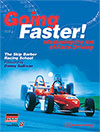|
|
Going Faster!
by Carl Lopez
Price: $44.95
|
Book Review
Nearly everyone who loves to drive has asked the question, "What will this baby do?" Author Carl Lopez has made a career out of teaching drivers to "go faster" at the Skip Barber Racing School. Going Faster! reveals his instruction methods.
The Barber school philosophy is that proper instruction and equipment, coupled with desire and perseverance, can train anyone to drive under race conditions. Central to the Barber method are three basics—line, corner exit speed, and braking. After a discussion of these fundamentals, each critical element is further broken down into its fine points. Lopez explains in detail how the characteristics of car and track will determine a driver’s reaction. He provides the reader with techniques for solving the problems, with real world examples illustrated in diagrams and pictures of racing situations on the Sebring test track.
The book stresses reliance on preparation and analysis, not just instinct. The reader learns how to map a racetrack and recognize its key features. Throughout the book are charts reflecting the author’s background in the use of race car data to develop optimal responses to track conditions.
But just about the time you are ready to suit up, Lopez dumps a bucket of cold racing reality on you. He discusses accidents, race track errors, and driving in the rain, as well as other impediments to glory. Racing is expensive and sponsorships are few, but if you’ve got the money, he tells you what kind of car to look for and how to set it up. He also lets the reader know what to expect when starting a racing career, and gives valuable advice on "making it"—whether at the top level or as a weekend club racer.
Throughout the text are fascinating sidebars by experienced racers providing unique insight into the way that professionals deal with the situations described in the text, and how they put these methods into practice.
Going Faster! is fully indexed and contains an appendix that includes schools, racing organizations, and publications. There is also a bibliography and a glossary of racing terms.
Three types of readers will find Lopez’ work particularly useful: the would-be racer who wants a real taste of what the track is like, the driver who wants to improve, and the racing fan who wants better to understand what he sees going on at the track. All will be rewarded by a thorough read of this excellent book.
![[B] Bentley Publishers](http://assets1.bentleypublishers.com/images/bentley-logos/bp-banner-234x60-bookblue.jpg)
